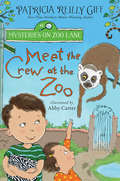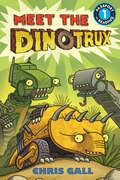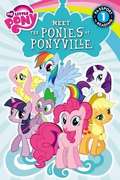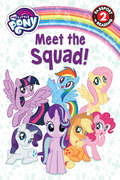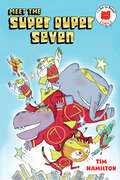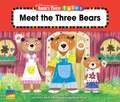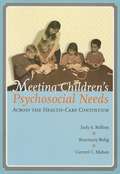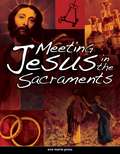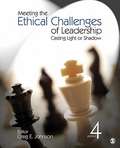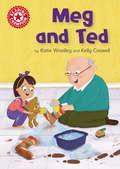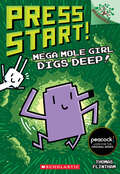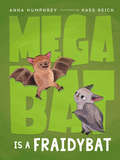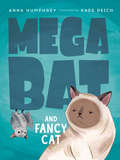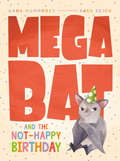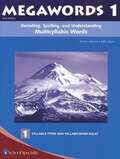- Table View
- List View
Meet the Crew at the Zoo (Mysteries on Zoo Lane #1)
by Patricia Reilly GiffSolve mysteries at a city zoo with a diverse group of kids in this illustrated chapter book from a two-time Newbery Honor author.Lions and tigers for neighbors? That doesn't bother Luke at all. It's making new friends that scares him. Not only has Luke had to move from Florida to New York because of his dad's new job as a zoo doctor, but he's also had to leave behind his best friend--his abuelo.When Luke discovers that there are other kids also living on Zoo Lane and that one of them might be the owner of a mysterious zebra-printed box left outside his house, he wonders if just maybe he can make friends and solve a mystery in this wild new place.In this first book of the series, two-time Newbery Honor author Patricia Reilly Giff has crafted a charming story about conservation, animal care, friendship, and problem-solving. In touch with the programs and initiatives that today's zoos are undertaking, Giff provides readers with a fresh look at the work of zoologists. Charming line artwork by Abby Carter appears throughout and keeps the story upbeat.
Meet the Dinotrux
by Chris GallA Level 1 early reader that introduces kids to the Dinotrux--and will get them roaring about reading!Includes Read-Aloud/Read-to-Me functionality where available. Also includes a Dolch Sight Words list.Book Description:In this beginning reader, Dozeratops wants to meet new Dinotrux. But they are on the other side of the river. Can the mighty monsters work together to build a bridge? Find out in this friendship adventure, where you will learn about ten of these part-dinosaur, part-truck beasts!
Meet the Helpers (Reach Into Phonics Ser.)
by Deborah J. Short Kate Pershing Ana GonzalezNIMAC-sourced textbook
Meet the Moviemakers (Fountas & Pinnell Classroom, Guided Reading Grade 4)
by Laura DowerNIMAC-sourced textbook
Meet the New Class: My Little Pony (Passport to Reading Level 1)
by Jennifer FoxPrincess Twilight Sparkle is opening a School of Friendship! Will her students get along? Meet the class and find out!An exciting leveled reader based on the new season of My Little Pony: Friendship is Magic!Passport to Reading Level 1 ©2018 Hasbro. All Rights Reserved.
Meet the Ponies of Ponyville (My Little Pony)
by Olivia LondonMeet all your favorite ponies in Ponyville! See where Twilight Sparkle, Rainbow Dash, Pinkie Pie, Rarity, Fluttershy and Applejack all live and meet their pets too!
Meet the Squad! My Little Pony (Passport to Reading Level 2)
by Celeste SislerStarlight Glimmer has the very best friends in all of Ponyville! Come meet Princess Twilight Sparkle, Rainbow Dash, Pinkie Pie, Fluttershy, Rarity, Applejack, and more in this charming leveled reader based on My Little Pony: Friendship is Magic!Featuring a winning combination of favorite licensed characters and carefully controlled text, reading along or reading alone just got more fun with Passport to Reading! All books include a parent letter, word count, Guided Reading level, and number of sight words.Level 2: Reading out Loud: Encourage developing readers to sound out loud, more complex stories with simple vocabulary.©2019 Hasbro. All Rights Reserved.
Meet the Super Duper Seven (I Like to Read Comics)
by Tim HamiltonThe seven silliest superheroes you will ever meet! This comical comic is perfect for first and second graders.Meet the Super Duper 7! Electro-Elephant can charge your phone. Hip-No-Hippo can put bad guys to sleep. And Hungry Kitty and her four brave birds . . . . But where are the four brave birds? How can the Super Duper 7 stop crime when Hungry Kitty keeps eating members of the Super Duper team? Maybe a mouse named Mr. Polka dot can help! Tim Hamilton&’s funny cartoons have appeared in The New Yorker and MAD Magazine. Comics-lovers can now share the fun with their kids, students, siblings, and younger friends who are learning to read! I Like to Read® Comics are perfect for kids who are challenged by or unengaged in reading, kids who love art, and the growing number of young comics fans. Filled with eye-catching art, humor, and terrific stories these comics provide unique reading experiences for growing minds. I Like to Read® Comics, like their award-winning I Like to Read® counterpart, are created by celebrated artists and support reading comprehension to transform children into lifelong readers. We hope that all new readers will say, &“I like to read comics!&” A Junior Library Guild Gold Standard Selection
Meeting Children's Psychosocial Needs Across the Healthcare Continuum
by Judy Rollins Rosemary Bolig Carmel MahanMeeting Children's Psychosocial Needs Across the Health-Care Continuum integrates current research and theory within the framework of the new and transitioning health-care environment. Despite the changes we experience now and in the future, children in health-care settings--in the home, child care center, school, community agency, ambulatory setting, or hospital--continue to need what they have always needed: the basics, such as nurturing, predictability, adequate stimulation, interaction, a sense of control, and mastery of their environments.
Meeting Jesus in the Sacraments
by Michael Amodei"Meeting Jesus in the Sacraments" roots the sacraments as the definitive way Jesus remains present to the Church and the world today. It expresses concrete ways for understanding the sacraments, participating in their rites, and benefiting from their graces. The text is organized around the traditional definition of sacrament from the "Catechism of the Catholic Church". This definition is clarified by arranging the chapters around four dimensions of the sacrament: memorial, celebration, communion, and transformation. Through regular placement of "For Reflection" panels and assignments that focus on deeper research, developing a personal and communal prayer life, and active transformation of self and society, this text allows students to come to know Jesus through participation in the sacraments and the grace of their effects. Selections from Catholic blogs and profiles of saints offer a practical application of the sacrament to teenagers. (C. 2010) This text has been found in conformity with the "Catechism of the Catholic Church".
Meeting the Ethical Challenges of Leadership: Casting Light or Shadow, 4th Edition
by Craig E. JohnsonUsing the metaphor of light or shadow, Craig E. Johnson shows how leaders have the power to do significant good or harm. Taking an interdisciplinary approach to leadership ethics, and balancing theory and research with opportunities for application, the book provides self-assessments, cases and films to analyze, and exploration exercises.
Meg and Ted: Independent Reading Red 2 (Reading Champion #366)
by Katie WoolleyThis story is part of Reading Champion, a series carefully linked to book bands to encourage independent reading skills, developed with Dr Sue Bodman and Glen Franklin of UCL Institute of Education (IOE)Meg likes to help - and she never goes anywhere without her trusted bear, Ted, who also likes to help!Reading Champion offers independent reading books for children to practise and reinforce their developing reading skills.Fantastic, original stories are accompanied by engaging artwork and a reading activity. Each book has been carefully graded so that it can be matched to a child's reading ability, encouraging reading for pleasure. Perfect for the 4-5 year old beginner reader or those reading book band red.
Mega Mole Girl Digs Deep!: A Branches Book (Press Start!)
by Thomas FlinthamMega Mole Girl has to save Super Rabbit Boy in the latest page-turning installment of this USA Today bestselling series!Pick a book. Grow a Reader!This series is part of Scholastic's early chapter book line, Branches, aimed at newly independent readers. With easy-to-read text, high-interest content, fast-paced plots, and illustrations on every page, these books will boost reading confidence and stamina. Branches books help readers grow!Rue has a new Mega Mole Girl game to play, and it looks hard. Sunny challenges her to finish the game. Is she up to the task? In the game, Miss Business has captured all the world's heroes, including Super Rabbit Boy, for her collection of rare treasures. Can Mega Mole Girl rescue the other heroes and save the day?Thomas Flintham's full-color artwork on every page brings energy and fun to this action-packed, gaming-themed series!
Megabat (Megabat #1)
by Anna HumphreyA sweet and hilarious chapter book about a boy and a bat, two unlikely friends who bond over loneliness, jellyrolls and Darth Vader.Daniel Misumi has just moved to a new house. It's big and old and far away from his friends and his life before. AND it's haunted . . . or is it?Megabat was just napping on a papaya one day when he was stuffed in a box and shipped halfway across the world. Now he's living in an old house far from home, feeling sorry for himself and accidentally scaring the people who live there. Daniel realizes it's not a ghost in his new house. It's a bat. And he can talk. And he's actually kind of cute. Megabat realizes that not every human wants to whack him with a broom. This one shares his smooshfruit. Add some buttermelon, juice boxes, a lightsaber and a common enemy and you've got a new friendship in the making!This charming, funny story is brought to life by Kass Reich's warm and adorable illustrations. There's never been a bat this cute -- readers will be rooting for Megabat and Daniel from page one!
Megabat Is a Fraidybat (Megabat #3)
by Anna HumphreyMegabat and his best friend, Daniel, go to sleepaway camp for the first time. Another hilarious chapter book in this laugh-out-loud series for fans of Dory Fantasmagory and Narwhal and Jelly.Daniel is not so sure about going to camp. There will be bugs. And uncomfortable beds. And leeches!Megabat can't WAIT to go to camp! There will be so much smooshfruit, and he loves a good sing-along. Daniel starts to think camp isn't so bad. He's made friends, and his bed isn't THAT uncomfortable.Megabat has made a new friend too. But his new friend wants him to go flying to spooky caves. And her mom is very toothy. As Daniel is getting into the swing of things and starting to enjoy camp, Megabat is getting himself into one tangle after another to avoid going into the scary woods. But can Megabat overcome his fears to help save his new friend? Kass Reich's adorable illustrations paired with Anna Humphrey's hilarious text make for another unforgettable Megabat adventure, one that will appeal to Megabat fans and newcomers!
Megabat and Fancy Cat (Megabat)
by Anna HumphreyMegabat returns, this time with a new nemesis: a very fancy cat. Can our tiny bat hero stop his Daniel's heart from being stolen by this nefarious, fluffy villain?Megabat was looking forward to Christmas morning: presents, playing toys, smooshfruit and watching Star Wars. But then Daniel opened his last, most special present.Daniel thinks this might be the best Christmas present yet: a beautiful cat named Priscilla! He's always wanted a pet. Megabat is not sure he likes this cat. She tastes most hairy. Daniel loves his new cat! She's fun to play with, and she's so soft and fluffy.Megabat is not soft OR fluffy. He's not purebred and he doesn't have a big, beautiful swishy tail. What if Daniel loves Priscilla more than Megabat? This is truly a disturbance in the Force. Megabat and Birdgirl must find a way to get rid of this trubble cat once and for all!Calamity ensues as Megabat and Birdgirl try to come up with ways to get rid of Priscilla. But is there more than meets the eye with this furry menace? Kass Reich's adorable illustrations paired with Anna Humphrey's hilarious text make for another unforgettable Megabat adventure.
Megabat and the Not-Happy Birthday (Megabat #4)
by Anna HumphreyIt's Daniel's birthday, and Megabat wants to join in all the fun, but his excitement gets the best of him and suddenly the birthday celebrations are on the brink of disaster. The next laugh-out-loud book in this sweet and funny chapter book series featuring a talking bat.Daniel isn't in the birthday party mood. He hates his new glasses -- they're dorky, and he feels silly in them. Megabat LOVES Daniel's new face windows! They make him dizzy and his tummy feel funny. And he loves parties even more! Daniel starts planning his party, and things are looking up -- all of his friends are excited, and he has some fun games planned. Plus: presents! Megabat's party excitement is losing steam. He has to hide the whole time. He can't eat any of the delicious buttermelon. And he can't participate in any games, even though it's the thing he wants most in the WHOLE WIDE WORLD. When Megabat loses his temper and breaks Daniel's best birthday gift, he realizes he's been a bad friend and gives Daniel what he thinks is the best possible gift: he runs away. But being alone in the big, wide, world is harder than he thought. Kass Reich's adorable illustrations paired with Anna Humphrey's hilarious text make for another unforgettable Megabat adventure, one that will appeal to Megabat fans and newcomers!
Megafauna: Gigantes del pasado (¡Arriba la Lectura!, Level W #76)
by Pamela RushbyNIMAC-sourced textbook
Megawords 1: Decoding, Spelling, and Understanding Multisyllabic Words, Syllable Types and Syllabication Rules
by Kristin Johnson Polly BayrdNIMAC-sourced textbook
Megawords 2: Decoding, Spelling, and Understanding Multisyllabic Words, Common Prefixes and Suffixes
by Kristin Johnson Polly BayrdNIMAC-sourced textbook
Megawords 3: Decoding, Spelling, and Understanding Multisyllabic Words, Schwa Sound
by Kristin Johnson Polly BayrdNIMAC-sourced textbook
